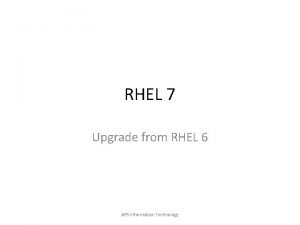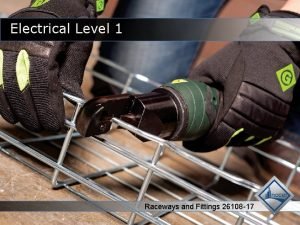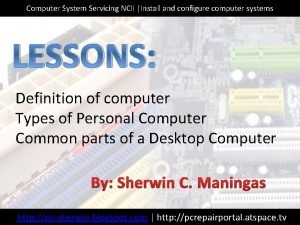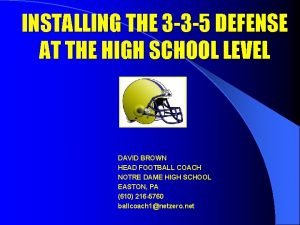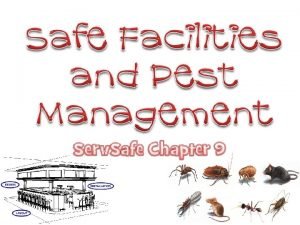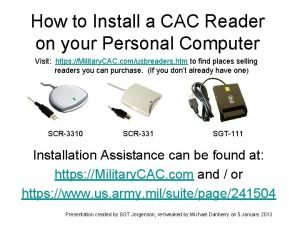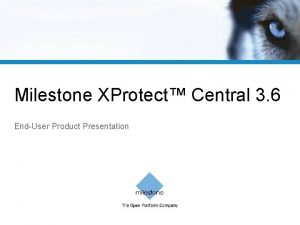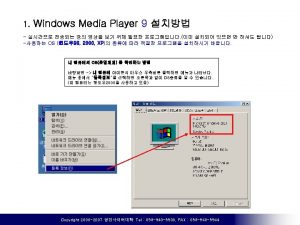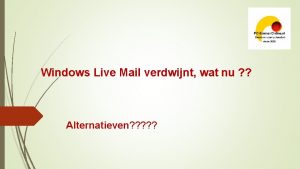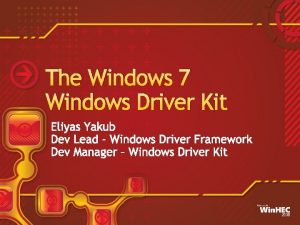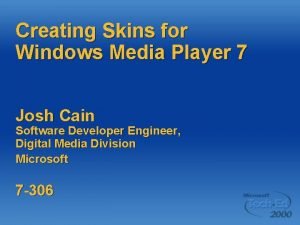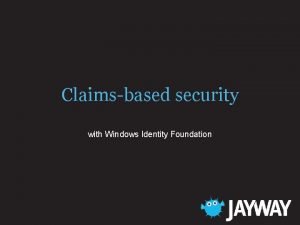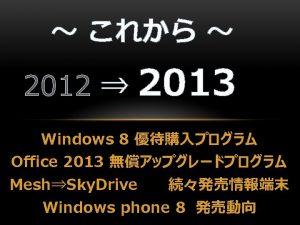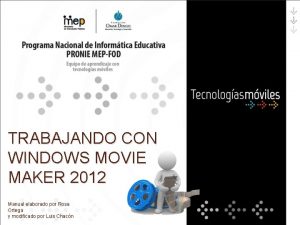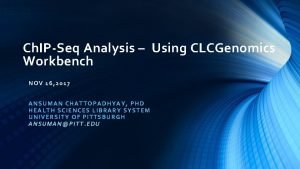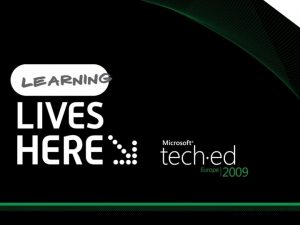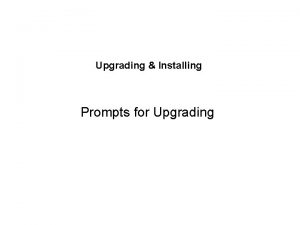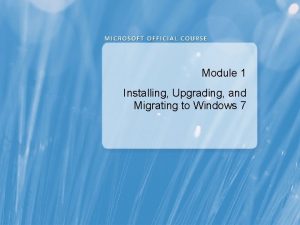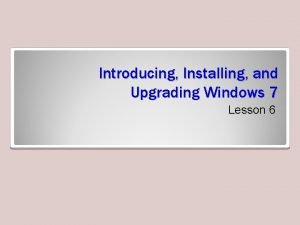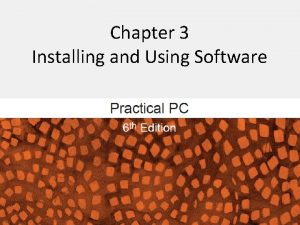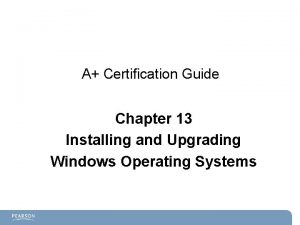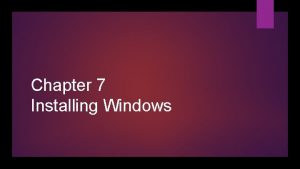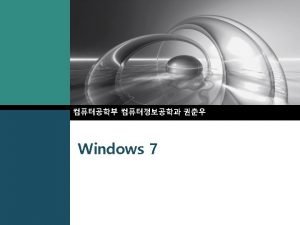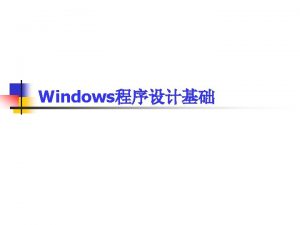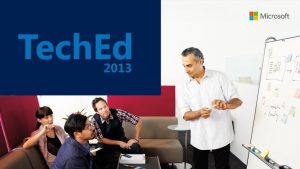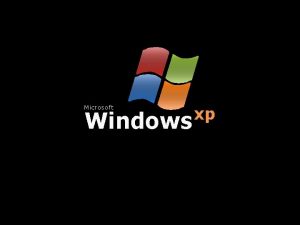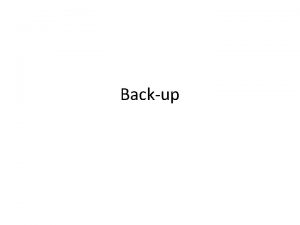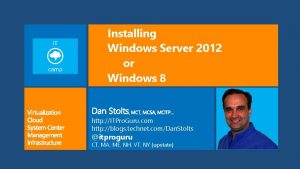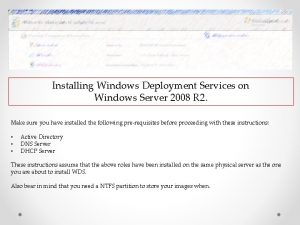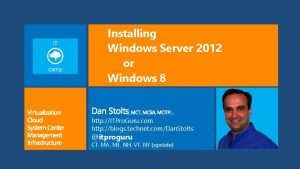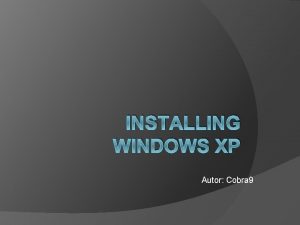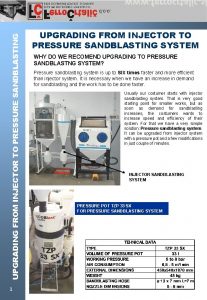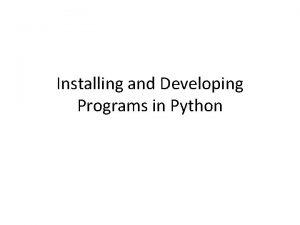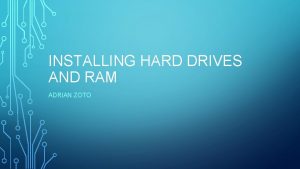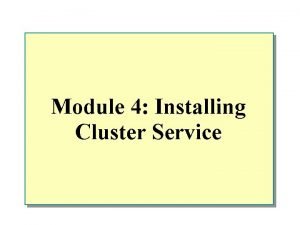Installing and Upgrading Windows Chapter 12 2007 The

















































- Slides: 49

Installing and Upgrading Windows Chapter 12 © 2007 The Mc. Graw-Hill Companies, Inc. All rights reserved

Overview • In this chapter, you will learn to – Identify and explain the basic functions and features of an operating system – Install and upgrade Windows 2000 and Windows XP – Troubleshoot installation problems © 2007 The Mc. Graw-Hill Companies, Inc. All rights reserved

Historical/Conceptual Functions of the Operating System © 2007 The Mc. Graw-Hill Companies, Inc. All rights reserved

Functions of an Operating System • Communicate with hardware • Provide a user interface • Provide a structure for access to applications • Enable users to manipulate programs and data © 2007 The Mc. Graw-Hill Companies, Inc. All rights reserved

Operating System Traits • An OS works only with a particular type of processor • An OS begins running as soon as the PC finishes its POST • Application programs cannot run on a PC without an OS – Programs use APIs (application programming interfaces) • Flexible—allows use of new software and hardware © 2007 The Mc. Graw-Hill Companies, Inc. All rights reserved

Operating System Traits • Different OSs require different applications Operating System Application Mac OS X Microsoft Office 2004 Windows XP Microsoft Office 2006 Linux Open. Office © 2007 The Mc. Graw-Hill Companies, Inc. All rights reserved

Communicating with Hardware • BIOS includes code that tells the computer how to talk to basic hardware – The OS works with BIOS to talk to these devices – When BIOS does not know how to talk to a piece of hardware, the OS talks directly to the device • Most OSs use device drivers provided by the manufacturer (Bring Your Own BIOS) to interpret the language necessary to talk to a new device – When there’s a problem, the OS should provide error handling or at least error notification © 2007 The Mc. Graw-Hill Companies, Inc. All rights reserved

Creating a User Interface • A user interface needs to – Show what applications are available – Provide an easy way to access applications – Provide a way to label and save the data – Disappear and allow the application to take over the screen © 2007 The Mc. Graw-Hill Companies, Inc. All rights reserved Pick a shoe Pick an application

Organizing Programs and Data • The OS needs to be able to organize and manipulate programs and data – Provides name (or label) for each program and each piece of data – Provides naming system for drives – Allows users to store data and programs in organized fashion – Allows users to manipulate data and programs © 2007 The Mc. Graw-Hill Companies, Inc. All rights reserved

Comp. TIA A+ Essentials © 2007 The Mc. Graw-Hill Companies, Inc. All rights reserved

Operating System Interfaces • Command-line interface – Character-based or text-based – Covered in Chapter 14 • Graphical user interface (GUI) – Uses icons and pictures – User interacts with OS by pointing and clicking with mouse © 2007 The Mc. Graw-Hill Companies, Inc. All rights reserved

Today’s Operating Systems Overview • Microsoft Windows • Apple Macintosh • UNIX • Linux © 2007 The Mc. Graw-Hill Companies, Inc. All rights reserved

Microsoft Windows • Corporate Users • • Windows NT 3. 1 NT 4. 0 2000 XP Pro • Home Users • Windows 9 x • Windows 95 • Windows 98 • Windows Me • XP Home • XP Media • Recently released—Windows Vista – Versions for corporate and home users © 2007 The Mc. Graw-Hill Companies, Inc. All rights reserved

General Windows Features • File systems – Corporate used NTFS – Home used FAT and FAT 32 – Today both supported, but NTFS used for security • Plug and Play – Appeared with Windows 95 – Migrated to corporate side with Windows 2000 © 2007 The Mc. Graw-Hill Companies, Inc. All rights reserved

Windows NT 4. 0, 2000 Pro, XP © 2007 The Mc. Graw-Hill Companies, Inc. All rights reserved

Windows XP • Ended the Windows 9 x product line • Windows XP Home – Basic features for home users • Windows XP Professional – Advanced features include security for corporate users • Windows XP Media Edition – Advanced features for home users include ability to watch TV and movies © 2007 The Mc. Graw-Hill Companies, Inc. All rights reserved

Windows Server Products • Windows NT 4. 0 Server • Windows 2003 Server © 2007 The Mc. Graw-Hill Companies, Inc. All rights reserved

Apple Macintosh • • Used GUI long before Windows Proprietary computers Current OS is OS X Macs now run on Intel CPUs • Uses BSD variant of UNIX © 2007 The Mc. Graw-Hill Companies, Inc. All rights reserved

UNIX • Oldest, most powerful OS • Many current OSs have concepts developed from UNIX • Open source—allows variants of OS © 2007 The Mc. Graw-Hill Companies, Inc. All rights reserved

Linux • UNIX-like OS written by Linus Torvalds • Runs on Intel/AMD processors • Free OS – Source code also freely available – Uses the GNU general public license (GPL) – Linux and applications bundled as Linux distributions (distros) © 2007 The Mc. Graw-Hill Companies, Inc. All rights reserved

Linux • Distributions – Fedora Core – Debian – Slackware – Ubuntu – Su. SE © 2007 The Mc. Graw-Hill Companies, Inc. All rights reserved

Installing and Upgrading Windows © 2007 The Mc. Graw-Hill Companies, Inc. All rights reserved

Preparing for Installation or Upgrade 1. 2. 3. 4. 5. 6. 7. 8. 9. Identify hardware requirements Verify hardware and software compatibility Decide: Clean install or upgrade? Back up data Select an install method Identify partition and file systems to use Determine computer’s network role Decide on language and locale settings Plan for post-installation tasks © 2007 The Mc. Graw-Hill Companies, Inc. All rights reserved

Identify Hardware Requirements Core Resources • CPU • RAM • Free hard disk space Miscellaneous • Video adapter • Display • Storage devices © 2007 The Mc. Graw-Hill Companies, Inc. All rights reserved

Verify Compatibility • Hardware and software • Use Windows Marketplace (formally known as Hardware Compatibility List) © 2007 The Mc. Graw-Hill Companies, Inc. All rights reserved

Clean Install or Upgrade • Clean install – Usually done on empty hard disk – All applications must be installed • Upgrade – New OS installs on top of the old one – Many previous settings and capabilities retained – Applications don’t need to be reinstalled • Multiboot – Doing a clean install side by side with another OS – Enables you to boot to more than one OS © 2007 The Mc. Graw-Hill Companies, Inc. All rights reserved

Other Installation Methods • When deploying many computers, automated methods used • Image—complete copy of OS and applications – Norton Ghost – Power. Quest’s Drive Image – Acronis’s True Image • Remote Installation Services (RIS) © 2007 The Mc. Graw-Hill Companies, Inc. All rights reserved

Back Up Data • If data saved to central server, this step can be skipped • If data exists on local drive, it needs to be backed up • Back up to network server, DVD, USB, hard drive, etc. – Will need to restore data from this location after upgrade or reinstall © 2007 The Mc. Graw-Hill Companies, Inc. All rights reserved

Select an Installation Method • Two basic choices – CD-ROM (A+ focus) • Boot from CD and start installation – Over the network (Network+ focus) © 2007 The Mc. Graw-Hill Companies, Inc. All rights reserved

Determine Partition & File System • Partition – Create when drive first created (or use third-party tools to repartition) – If multiboot, use one partition for each OS • File system – Use NTFS whenever possible—security features are valuable – If older OSs need FAT or FAT 32, use FAT or FAT 32 for their partition © 2007 The Mc. Graw-Hill Companies, Inc. All rights reserved

Miscellaneous • Network role – Standalone, workgroup, or domain – Environment determines choice • Language and locale settings – Languages and displays can be configured for different countries • Post-installation tasks – Install service packs, hotfixes, etc. – Install updated drivers – Install applications © 2007 The Mc. Graw-Hill Companies, Inc. All rights reserved

Install or Upgrade • Text mode – End user license agreement (EULA) – Partition hard disk – Files copied to hard disk • Graphical mode – Enter product key – Remaining installation completes • Upgrade disks are typically cheaper – Require OS to be already installed or separate disk used to verify upgrade disk can be used © 2007 The Mc. Graw-Hill Companies, Inc. All rights reserved

Post-Installation Tasks • Similar as required for clean install – Identify installation problems – Install patches, service packs, and updates – Upgrade drivers – Restore user data © 2007 The Mc. Graw-Hill Companies, Inc. All rights reserved

Windows 2000 Professional • Hardware Requirements Component CPU Memory Hard Disk Network Display Optical Minimum Pentium 133 MHZ 64 MB 2 GB with 650 MB free None VGA resolution Not required unless installing from CD © 2007 The Mc. Graw-Hill Companies, Inc. All rights reserved Recommended Pentium II 350 MHZ 128 MB 6. 4 GB with 2 GB free Modern NIC SVGA resolution Not required unless installing from CD

Install Upgrade XP Pro • Upgrade paths Windows 98 Windows Me Windows NT 4. 0 SP 5 or later Windows 2000 Pro (including SPs) Windows XP Home © 2007 The Mc. Graw-Hill Companies, Inc. All rights reserved Windows XP Pro

XP Professional • Hardware Requirements Component Minimum CPU Intel or AMD 233 MHZ Memory 64 MB Hard Disk 1. 5 GB available hard drive space Network None Display Optical Recommended Intel or AMD 300 MHZ 256 MB 4 GB available hard drive space Modern NIC Direct. X version 8 800 X 600 resolution Any CD or DVD drive © 2007 The Mc. Graw-Hill Companies, Inc. All rights reserved

XP Pro Compatibility • Upgrade Advisor – First process that runs from setup. exe – Provides list of devices and software known to have issues with XP – Can be run by itself • From Microsoft’s Web site • Or winnt 32 /checkupgradeonly – On the installation CD or can be downloaded for free © 2007 The Mc. Graw-Hill Companies, Inc. All rights reserved

XP Installation • Bootable CD-ROM boots into setup – May need to set boot order in BIOS • Registration—optional • Activation – Mandatory within 30 days – Anti-piracy mechanism – System disabled after 30 days if not activated – Via Internet or phone © 2007 The Mc. Graw-Hill Companies, Inc. All rights reserved

2000 and XP Upgrade Issues • Can upgrade to 2000 Pro from 95 and 98 but not Me • Some 9 x applications won’t run on 2000 and XP • Third-party disk compression applications not supported on 2000/XP • Third-party power management applications can cause problems with 2000/XP installation © 2007 The Mc. Graw-Hill Companies, Inc. All rights reserved

Pre-Upgrade Steps • • • Check compatibility Back up data and configuration files Perform “spring cleaning” Perform disk scan and defrag Uncompress all Perform virus scan and disable or remove virus-checking software • Disable CMOS virus checking • Be prepared to do clean install © 2007 The Mc. Graw-Hill Companies, Inc. All rights reserved

2000/XP Clean Install • Steps same for both • Start by booting to CD-ROM • Text mode – Can partition drive in this mode – Choose file system (usually NTFS) © 2007 The Mc. Graw-Hill Companies, Inc. All rights reserved

2000/XP Clean Install • Graphical mode • Enter product key – Good idea to write this on the CD © 2007 The Mc. Graw-Hill Companies, Inc. All rights reserved

2000/XP Clean Install • Configure computer name and administrator password • Network settings © 2007 The Mc. Graw-Hill Companies, Inc. All rights reserved

Automating the Install • Scripted installation – – Setup Manager creates answer files Available on CD or can be downloaded Creates answer files for multiple OSs Fully automated or partially automated © 2007 The Mc. Graw-Hill Companies, Inc. All rights reserved

Automating the Install • Disk cloning problem – Unique security identifier (SID) is not unique if cloned • Solution – Ghost. Walker or New. SID can be used to create new SID – Sysprep sanitizes many unique settings on a computer such as SID © 2007 The Mc. Graw-Hill Companies, Inc. All rights reserved

Troubleshooting Installation Problems © 2007 The Mc. Graw-Hill Companies, Inc. All rights reserved

Text Mode Errors • No boot device – Either startup disk is bad, or CMOS not set to boot off CD-ROM first • Windows Setup requires X amount of available drive space – Check formatting and/or space of C: drive • Not ready error on optical drive – Check the CD-ROM drive and disc • BSOD – Probably due to hardware incompatibility – Check KB 165863 © 2007 The Mc. Graw-Hill Companies, Inc. All rights reserved

Graphical Mode Errors • Hardware detection errors – Could be hardware incompatibility – If non-critical hardware, find and install correct drivers • Can’t read CAB files – Check the CD-ROM for scratches – Try copying i 386 files onto hard drive – Replace the CD-ROM © 2007 The Mc. Graw-Hill Companies, Inc. All rights reserved

Lockups During Install • Smart recovery, repair install – Unplug system and restart – Will automatically start where it left off • Optical drive, hard drive – Try another disc or another CD-ROM drive • Log files—track progress of install – Setuplog. txt – Setupapi. log © 2007 The Mc. Graw-Hill Companies, Inc. All rights reserved
 Rhel 6 to 7 upgrade
Rhel 6 to 7 upgrade Flexicoking
Flexicoking Electrical raceways and fittings
Electrical raceways and fittings In css nc ii, avr stands for
In css nc ii, avr stands for Fusioncompute installation step by step
Fusioncompute installation step by step Installing fiber optic fence cable
Installing fiber optic fence cable Installing silt fence by hand
Installing silt fence by hand Installing the 3-3-5 defense
Installing the 3-3-5 defense Signage posted at a handwashing station must include
Signage posted at a handwashing station must include Cac reader installation
Cac reader installation Installing milestone xprotect
Installing milestone xprotect Windows live movie maker transitions
Windows live movie maker transitions Windows media player 9 windows 7
Windows media player 9 windows 7 Windows live mail windows 8
Windows live mail windows 8 Windows driver kit windows 7
Windows driver kit windows 7 Windows movie maker windows 7
Windows movie maker windows 7 Windows media player skins for windows 10
Windows media player skins for windows 10 Windows identity foundation windows 10
Windows identity foundation windows 10 Upgrade windows 7 to windows 10
Upgrade windows 7 to windows 10 Windows xp for virtualbox download
Windows xp for virtualbox download Windows mobile center windows 10
Windows mobile center windows 10 Manual windows movie maker
Manual windows movie maker Windows vista windows 10
Windows vista windows 10 Jake oshins
Jake oshins Hát kết hợp bộ gõ cơ thể
Hát kết hợp bộ gõ cơ thể Ng-html
Ng-html Bổ thể
Bổ thể Tỉ lệ cơ thể trẻ em
Tỉ lệ cơ thể trẻ em Gấu đi như thế nào
Gấu đi như thế nào Tư thế worms-breton
Tư thế worms-breton Chúa yêu trần thế
Chúa yêu trần thế Môn thể thao bắt đầu bằng chữ f
Môn thể thao bắt đầu bằng chữ f Thế nào là hệ số cao nhất
Thế nào là hệ số cao nhất Các châu lục và đại dương trên thế giới
Các châu lục và đại dương trên thế giới Cong thức tính động năng
Cong thức tính động năng Trời xanh đây là của chúng ta thể thơ
Trời xanh đây là của chúng ta thể thơ Cách giải mật thư tọa độ
Cách giải mật thư tọa độ Làm thế nào để 102-1=99
Làm thế nào để 102-1=99 Phản ứng thế ankan
Phản ứng thế ankan Các châu lục và đại dương trên thế giới
Các châu lục và đại dương trên thế giới Thơ thất ngôn tứ tuyệt đường luật
Thơ thất ngôn tứ tuyệt đường luật Quá trình desamine hóa có thể tạo ra
Quá trình desamine hóa có thể tạo ra Một số thể thơ truyền thống
Một số thể thơ truyền thống Cái miệng xinh xinh thế chỉ nói điều hay thôi
Cái miệng xinh xinh thế chỉ nói điều hay thôi Vẽ hình chiếu vuông góc của vật thể sau
Vẽ hình chiếu vuông góc của vật thể sau Nguyên nhân của sự mỏi cơ sinh 8
Nguyên nhân của sự mỏi cơ sinh 8 đặc điểm cơ thể của người tối cổ
đặc điểm cơ thể của người tối cổ Ví dụ về giọng cùng tên
Ví dụ về giọng cùng tên Vẽ hình chiếu đứng bằng cạnh của vật thể
Vẽ hình chiếu đứng bằng cạnh của vật thể Tia chieu sa te
Tia chieu sa te
